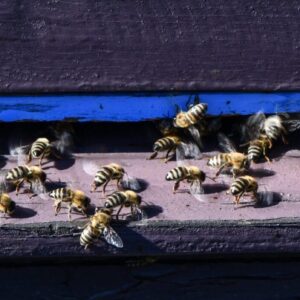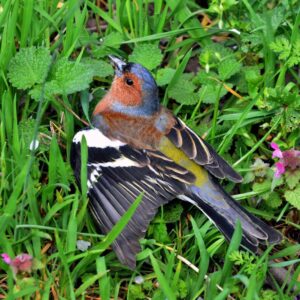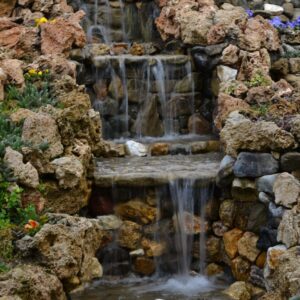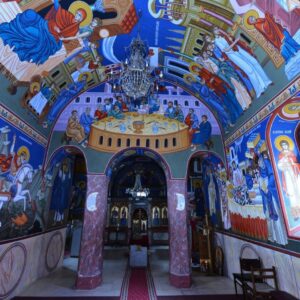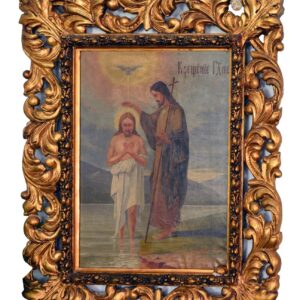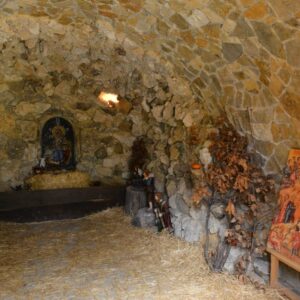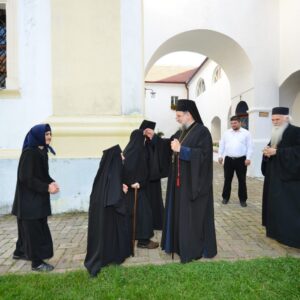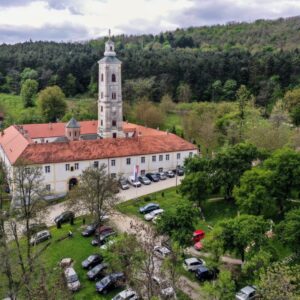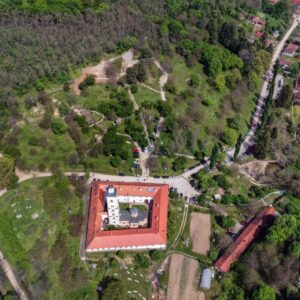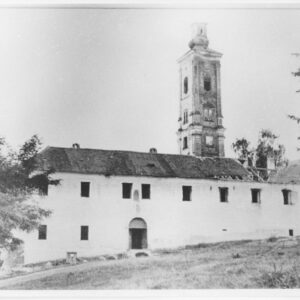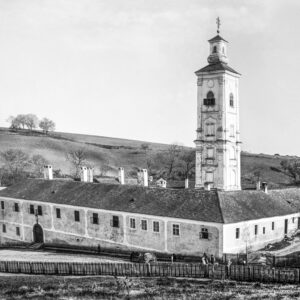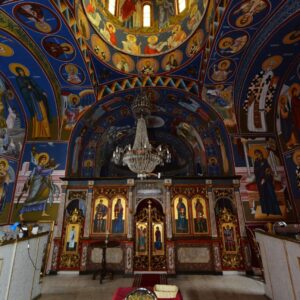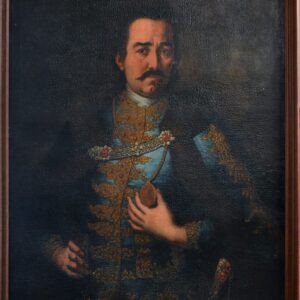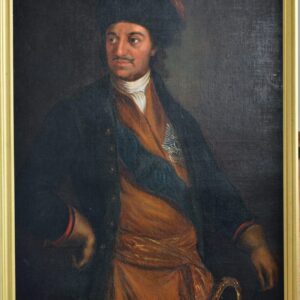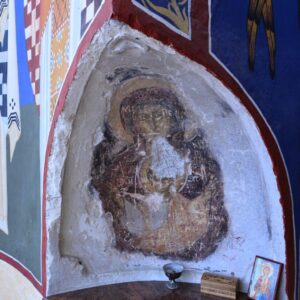Velika Remeta Monastery
First mentions and early history
An irrevocable mention of this monastery dedicated to the Holy Great Martyr Dimitri is found in 1543, although there are several decades older data on monastic communities with a similar name. The toponym Remeta can lead to the conclusion that there used to be a monastery of hermits (eremita) in that place. A record that was kept in the monastery archive, from the beginning of the 20th century, says: “It has been said that a certain Leontije, Illyrian eparch, built the present-day monastery, but we don’t know when”. Based on that note, it was presumed that it is the oldest monastic family in Fruška gora, because it seemed to have been founded in the first centuries of the Christian faith. Later it would turn out that this record refers to the temple in Sirmium, which was also dedicated to the Great Martyr of Thessalonica. The first mention of the full name of Velika Remeta was most likely the document from 1562, by which the Turkish authorities allowed the ascetics there to build a bakery and “other similar buildings in places where such buildings had been located before”. The same source also reveals that the hegumen “bought three meadows from various subjects and therefore they rightfully belong to him”.
It is also possible that one emissary of the Despotess Angelina, described in a document from 1509 as a “Demetrian” monk, belonged to the presumed brotherhood of this saint. Another folk tradition tried to shed light on the mystery of the origin of Velika Remeta, which designates Saint King Dragutin as its first founder. Clearly and unambiguously, the duration of the monastery under this name was confirmed in the permit issued to its hegumen in 1566, which enabled him to repair the temple damaged by fire. Two years later, during the administration of Hegumen Zosima, niches were painted on the exterior walls of the church with the following icons: the Holy Great-Martyr Demetrius, the Virgin and Child with the Archangels Michael and Gabriel, and three unidentified figures of saints. On that occasion, the interior of the church was also painted, and the remains of the painting from that time were preserved over the deacon’s room and prothesis (“Virgin Odigitria Orans” and “Christ the Merciful”).
In the first decades of the 17th, Hegumen Antonije of Remeta, like other hegumens of Fruška gora, sought material support in Russia due to “nameless misery”. The war damages, acquired between 1683 and 1699, were removed in the first decade of the 18th century, but there are also sources according to which the successful restoration was carried out thanks to the “beautiful aid” that arrived from Russia of Peter the Great. Abbot Giovanni Bonini wrote in 1702 that Velika Remeta owned 206 acres of arable land and a “healing spring”, which was restored by Marko Prokopijević in 1774. In 1716, the monastery suffered again, together with Krušedol, when, retreating in front of Eugene of Savoy, it was devastated by the Turkish army. Two years before this accident, the name of the local hegumen, Hieromonk Grigorije, was recorded.
The mentioned destruction preceded a longer period of spiritual and intellectual development of the monastic community, as well as a significant increase in its property. Jerotej Račanin, who wrote his “Journey to Jerusalem” in 1721, also lived in this place for a while. The building was completely renovated primarily thanks to the generous contribution of Metropolitan Vikentije (Popović Hadžilavić), made in 1722, thanks to which a part of the dormitory north of the monastery church was built in the following period. In addition to the first metropolitan of Karlovci, the meritorious founders of Velika Remeta were the nobles Andrej Andrejević, the administrator of the Karlovci estate, and his brother Jakov, tenant of the post office in Beška, who, between 1733 and 1735, built a high baroque bell tower. Furthermore, there is Lazar and Mihailo Vukadinović (Čokrljanović), with his sons Georgije and Marjan Oberknez, who erected the domes on the temple and, finally, the citizens of Novi Sad, “Dimitrije Polzović and St. Maković”, donors of the Holy Table.
Temple and the dormitory
The “Description” from 1753 states that the “cross-shaped”, brick-built temple, with an altar apse and a polygonal dome over projecting analogions, was vividly painted with dilapidated “old painting”, while it housed a new archbishop’s throne and 28 other tables. Among the Christian holy places, a fragment of the relics of St. George and a part of the bones of the “new St. Dimitri in Silver Chains” were kept in this place, and in 1709, Fruška gora Metropolitan Stefan (Metohijac) was buried there. On the same occasion, valuable documents that were then kept in the monastery archive were listed, such as the privilege of Charles I from June 23, 1722, two confirmations of Maria Theresa from December 20 and January 19, 1747, their copies with a reambulation plan, bound in leather and certified with the ruler’s seal, the Resolution of General Baron von Engelshofen from December 24, 1748 and “a whole bundle of Turkish certificates”. Dejan Medaković wrote how Patriarch Arsenije IV brought the “cross of the Venerable Tree, chained with silver” from Velika Remeta to the palace chapel of the Holy Great Martyr Tryphon.
The “Description” also mentions the first known iconostasis in Velika Remeta, “all gilded” and with a wooden cross on top. Unfortunately, the original, low iconostasis partition has not been preserved, but it can be guessed that it was made of works of art originating from different periods, while the throne icons, with the Second Migration of the Serbs, in 1739, arrived from the Rakovica Monastery. The iconostasis was rebuilt and reconstructed in 1850, at the expense of Maksim Nikolić Mišković, a “doctor of medicine from Sase, native of Karlovci”, otherwise the court physician of Prince Miloš Obrenović. It consisted of a large “Crucifixion” and representations of twelve prophets, twelve apostles and twelve feasts, performed by unknown or lesser-known artists, as well as throne icons, which belonged to the “circle of Simeon Ushakov, one of the great masters of the so-called armed palace from Moscow”. The icons of Saint John the Forerunner, Holy Father Nicholas, the Holy Three Hierarchs and the Virgin with Christ and the prophets were painted by the Russian court painters, Tikhon Ivanov, Leontius Stefanov, Ivan Maksimov and Spiridon Grigoriev.
In the fourth decade of the 19th century, the monastery complex of Velika Remeta was described as a smaller temple, surrounded by the dormitory and next to which the German builder Johannes Wilhelm built an extremely high bell tower, with a chapel dedicated to the Nativity of St. John the Forerunner. The modest church was also built in a “cross-shaped” form, between 1733 and 1735, with a dome resting on longitudinal and transverse arches. In its altar stands the Holy Table made of bricks “on one column”, consecrated by “Nikanor Krušedolski”, on November 2, 1735. The chapel called “Ubavac vodica” was built by the blind Marko Prokopljević from the village of Petrovčić, who is believed to have regained his sight after washing with the healing water here. Major renovation of the monastery was carried out in 1881 and the dome above the narthex was reconstructed in 1899.
Treasury of the monastery
Until the First World War, the monastery property had 656 cadastral acres of forest and arable land, 33 objects that were assessed as “valuables”, but also a library that numbered 250 titles, including manuscript scrolls and the “Gospel” from 1580, decorated by Archpriest Jovan from Kratovo.
Two important portraits are kept in the monastery hall. On one, the image of Andrej Andrejević, the founder of the bell tower, is immortalized, while on the other, the Russian emperor Peter the Great. The history of this second work of art is related to the generous financial aid that the St. Petersburg State Councilor Alexander Hilferding sent to the Velika Remeta’s Hegumen Irinej (Lazarević) in 1859. During his visit to this Syrmian sanctuary, inspired by Christian feelings, Hilferding was struck by the beauty of the “face of the pious emperor” from the “poor” ascetic cells. Judging by the local, oral tradition, the merciless reformer, while touring the progressive and enlightened Europe, also stopped in Velika Remeta, where he left the above-mentioned picture as a prayerful memory to its inhabitants. However, it is most likely that the newly escaped monks of the Rakovica monastery brought this important symbol of imperial favor in 1739, together with the charter of Peter the Great, which granted the monks the right to collect alms in his country. The discovery of this portrait caused great interest in the Russian capital. In 1880, Belgrade Metropolitan Mihailo, after the intervention of Konstantin Pobedonostsev, the powerful Chief Procurator of the Holy Synod of the Russian Orthodox Church, addressed Patriarch German (Anđelić) on this issue, proposing that the Russian Empire receives the original, while in return the monastery would receive a rich monetary compensation, as well as a faithful copy of the requested artwork. Hegumen Evlogije (Kuzmanović) and Hieromonk Joanikije (Jovanović) decided to accept the offer of the Russian envoy Nikanor Vasilyevich. Thus, the current salon of Velika Remeta is decorated only with a copy of the former emperor’s portrait. However, in the following year, according to the agreement reached, the necessary, thorough repair of the impoverished monastery was started and it entered the next century covered with solid roof tiles, instead of dilapidated, unsuitable shingles. For the next ten years, the archpriest of the Russian Church in Vienna came to Velika Remeta every year, bringing “various church valuables from Russia”.
Sufferings and renewals
Under the occupation by the Independent State of Croatia, Velika Remeta was looted, detonated and set on fire, while the brotherhood was expelled, together with its Hegumen Melentije (Babić). The vault over the narthex and the domes of the temple were demolished, the iconostasis was almost completely destroyed, while the dormitories were badly damaged and partially burned. In the first post-war years, the agricultural cooperative of Irig made a cattle pen out of the sad ruins and after 1948 it housed the convicts who were engaged in the construction of the partisan road. Their guards, looking for gold, dug up the grave of Stefan (Metohijac) and tore off the panagia, pectoral cross and ring from his remains. A little later, the dormitories were converted into a student resort. The first restoration and conservation works on the renovation of the dormitory began when the municipality of Zemun leased this area in order to convert it into a summer resort in 1951. The temple was temporarily covered in 1959 and its entire reconstruction was completed only in 1982. The Museum of the History of Old Serbian Music was also located here for a while.
The monastic family was restored in this sanctuary in 1971, with the arrival of hieromonk and later Hegumen and Archimandrite Danilo (Zdravković), when the contract under which the sacred building was usurped for a children’s resort expired. Prior to that, the monastery administration was entrusted to the hegumen of Grgeteg. Seven years later, the nuns Rafaila and Gavrila, who arrived from the monastery of Saint Melanija in Zrenjanin, settled in Velika Remeta. Hegumen Danilo demanded from the competent institutions to initiate the restoration of the temple of Saint Demetrius and the replacement of the temporary roof covering, pointing out its cultural and historical importance. He asked for the protection of the remains of the ancient fresco in the refectory and the stone slab on the southern facade of the church, which testified to the time of the construction of the distinctive bell tower. Finally, the “masonry and facade shop of Momčilović Stojanče”, after the approval of the expert commission, plastered the interior of the monastery church in 1983.
In 1989, the roof and domes were covered with copper sheet, the tombs in the nave were explored and the walls and floor of the place of worship were reconstructed. After the completion of these works, “Viktor the Russian” was engaged in painting the new chapel in the dormitory, but he soon suffered criticism from the expert commission that he “does not possess the necessary artistic and aesthetic qualities for such an important monastery complex”. Although the monastery administration accepted that opinion, the painting of the temple was later continued in a similar manner.
In August 1997, a wild storm brought down the roof and damaged the walls of the bell tower and the place of worship, which is why the new superior, Hegumen Stefan (Vučković) (Archimandrite Danilo passed away on January 8, 2000), contacted the relevant institutions. He substantiated his request with the argument that “there are frescoes here that have been damaged and continue to be damaged by birds and atmospheric changes, and their urgent conservation is needed”. Finally, the fraternity acquired a copper sheet, which was used to re-roof the tower, while plastering and painting of its walls were carried out again. In 2002, the western wing of the dormitory was built due to the efforts of the new hegumen and in 2006 and 2007 the necessary economic buildings were also built. The cells in the dormitory, representative rooms, kitchen and dining rooms were arranged as well. In addition, a monumental gate was erected and central heating and new electrical installations were introduced. By 2008, a guest house was built at the entrance to the monastery, as well as a new chapel on Ubavac.
The preserved parts of the old iconostasis of Velika Remeta were transferred to the Museum of the Serbian Orthodox Church in Belgrade. Only a few icons remain in Krušedol, including the “Holy Mother of God” by Leonti Stefanov, “Saint John the Baptist” by Ivan Maksimov, “Saint Nicholas” by Spiridon Grigoriev and “Holy Three Hierarchs” by Tikhon Ivanov. All the listed works of art were loaned to the Matica Srpska Gallery in 1958 and, since then, only the throne icon of the Savior, executed by an unknown artist, as well as Leonti’s “The Virgin”, painted with tempera on board, have been returned to the monastery in 1687. The altar area of the temple of the Holy Great Martyr Demetrius is today surrounded by a completely new wooden iconostasis painted by Dragan Marunić.
The old monastic cemetery is located in the forest, near the monastery, while the new one was established on its southern side. Apart from Metropolitan Stefan (Metohijac), Andrej and Jakov Andrejević, 1735, Abbot Georgije (Kurjaković), 1889, and Isak (Pragič) were buried in the temple of the Holy Great Martyr Demetrius and the churchyard. The dormitory consist of a salon, a winter chapel dedicated to the Assumption of the Blessed Virgin Mary, a library, a large and a small dining room, the bishop’s suite and monastic cells. Today, the monks of Velika Remeta producce honey and brandy and they have also developed a very fruitful publishing activity. Larger councils are held on St. John’s Day (July 7), Our Lady’s Day (August 28), St. Demetrius’ Day (November 8) and on the Second Sunday of the Easter fast.


